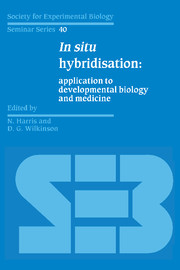Book contents
- Frontmatter
- Contents
- List of contributors
- Preface
- Non-radioisotopic labels for in situ hybridisation histochemistry: a histochemist's view.
- Use of haptenised nucleic acid probes in fluorescent in situ hybridisation
- The use of complementary RNA probes for the identification and localisation of peptide messenger RNA in the diffuse neuroendocrine system
- Contributions of the spatial analysis of gene expression to the study of sea urchin development
- Advantages and limitations of in situ hybridisation as exemplified by the molecular genetic analysis of Drosophila development
- The use of in situ hybridisation to study the localisation of maternal mRNAs during Xenopus oogenesis
- In situ hybridisation in the analysis of genes with potential roles in mouse embryogenesis
- Evolution of algal plastids from eukaryotic endosymbionts
- Localisation of expression of male flower-specific genes from maize by in situ hybridisation
- Tissue preparation techniques for in situ hybridisation studies of storage-protein gene expression during pea seed development
- Investigation of gene expression during plant gametogenesis by in situ hybridisation
- Sexing the human conceptus by in situ hybridisation
- Non-isotopic in situ hybridisation in human pathology
- The demonstration of viral DNA in human tissues by in situ DNA hybridisation
- Index
The demonstration of viral DNA in human tissues by in situ DNA hybridisation
Published online by Cambridge University Press: 04 August 2010
- Frontmatter
- Contents
- List of contributors
- Preface
- Non-radioisotopic labels for in situ hybridisation histochemistry: a histochemist's view.
- Use of haptenised nucleic acid probes in fluorescent in situ hybridisation
- The use of complementary RNA probes for the identification and localisation of peptide messenger RNA in the diffuse neuroendocrine system
- Contributions of the spatial analysis of gene expression to the study of sea urchin development
- Advantages and limitations of in situ hybridisation as exemplified by the molecular genetic analysis of Drosophila development
- The use of in situ hybridisation to study the localisation of maternal mRNAs during Xenopus oogenesis
- In situ hybridisation in the analysis of genes with potential roles in mouse embryogenesis
- Evolution of algal plastids from eukaryotic endosymbionts
- Localisation of expression of male flower-specific genes from maize by in situ hybridisation
- Tissue preparation techniques for in situ hybridisation studies of storage-protein gene expression during pea seed development
- Investigation of gene expression during plant gametogenesis by in situ hybridisation
- Sexing the human conceptus by in situ hybridisation
- Non-isotopic in situ hybridisation in human pathology
- The demonstration of viral DNA in human tissues by in situ DNA hybridisation
- Index
Summary
Introduction
The extraction of single-stranded human DNA, its separation by gel electrophoresis, its transfer to a nitrocellulose filter (the Southern blot) followed by hybridisation with a radioactively labelled viral probe consisting of a complementary DNA sequence forms the fundamental basis of the now well-established technique of DNA hybridisation. Dot blot hybridisation is a, more rapid variation of this basic technique.
However, the histopathologist is concerned with morphology and topographical relationships within tissue sections and the investigation of DNA bands does not allow one to precisely localise viral DNA within human tissues. But now the methods of molecular biology and immunohistochemistry have come together to allow the specific recognition of viral DNA in tissue sections.
Since 1985 there has been an increasing number of publications on the subject of in situ hybridisation for human papillomavirus (HPV) DNA. Our own work in this field was always aimed at developing a technique that was applicable to the routinely fixed and processed material in a hospital diagnostic histopathology laboratory (Lewis et al., 1987; Wells et al., 1987). Such a technique would permit the retrospective evaluation of archival material, thus considerably widening the scope for investigating the viral status of a variety of pathological lesions.
Numerous detection systems have been developed to visualise labelled gene probes. Autoradiography has been used to detect radio-labelled probes in cell smears and paraffin sections (Gupta et al., 1985). Although autoradiographical techniques are very sensitive, the use of radio-labelled material is unsuitable for most routine applications.
- Type
- Chapter
- Information
- In Situ HybridisationApplication to Developmental Biology and Medicine, pp. 271 - 284Publisher: Cambridge University PressPrint publication year: 1990



